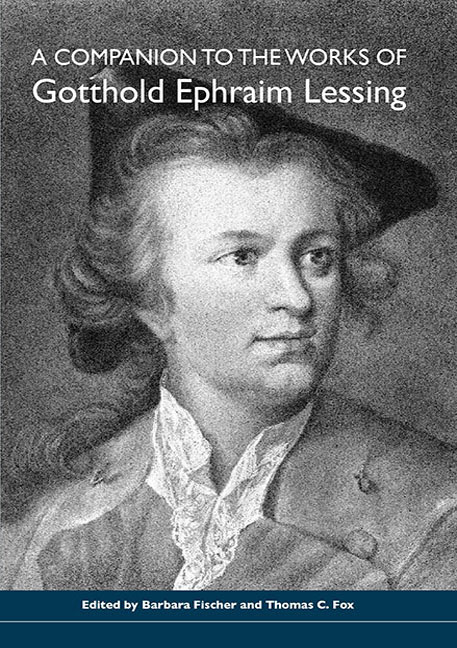Book contents
- Frontmatter
- Contents
- List of Illustrations
- Acknowledgments
- Lessing Editions and Abbreviations
- Selected Works by Lessing
- Introduction
- Lessing's Life, Work, and Times
- Criticism and Aesthetics
- Philosophy and Theology
- Drama and Drama Theory
- Reception
- Lessing and the Third Reich
- Lessing on the German-Speaking Stage in the Federal Republic of Germany, Austria, and Switzerland, 1945–1990
- Lessing on the East German Stage and Screen
- Modern Criticism in Historical Context: 200 Years of Lessing Reception
- Contact Organizations
- Works Cited
- Notes on the Contributors
- Index
Lessing and the Third Reich
from Reception
Published online by Cambridge University Press: 28 April 2017
- Frontmatter
- Contents
- List of Illustrations
- Acknowledgments
- Lessing Editions and Abbreviations
- Selected Works by Lessing
- Introduction
- Lessing's Life, Work, and Times
- Criticism and Aesthetics
- Philosophy and Theology
- Drama and Drama Theory
- Reception
- Lessing and the Third Reich
- Lessing on the German-Speaking Stage in the Federal Republic of Germany, Austria, and Switzerland, 1945–1990
- Lessing on the East German Stage and Screen
- Modern Criticism in Historical Context: 200 Years of Lessing Reception
- Contact Organizations
- Works Cited
- Notes on the Contributors
- Index
Summary
Two-and-a-half minutes into Hans Schweikart's film Das Fräulein von Barnhelm (1940), Prussian soldiers march past a hill on which a large windmill stands. The camera cuts back and forth between the marching soldiers and the windmill, which fills the screen with sails suggestive of an enormous swastika. Viewers familiar with Lessing might think not of Nazi iconography on seeing the windmill, however, but of Lessing's description of himself in the Briefe antiquarischen Inhalts (Letters of Antiquarian Content, 1768–69) as a windmill standing alone on a sand hill, helping — and wishing to be helped by — no one. Lessing employs this description in his rebuke of the classical philologist Christian Adolf Klotz and the art historian Friedrich Justus Riedel, who had brazenly cast him as the principal member of what they regarded as a despotic school of Berlin literary critics. If he had been in the audience to see how the windmill in Das Fräulein von Barnhelm is meant to symbolize Prussia as the forerunner of Nazi Germany, Lessing might well have used the windmill motif once more, both to assert his autonomy and to express his ire over the misappropriation of his views. His cultural meta-presence creates, and may well have done so for many at the time, an incongruous subtext in the film — one in which a defiant Lessing rejects the Nazi falsification of his work.
This unintended ambiguity is emblematic of Lessing's peculiar place in the Nazi literary landscape. With works such as Die Juden (The Jews, 1754) and Nathan der Weise (Nathan the Wise, 1779), Lessing necessarily stood, like a solitary windmill, outside of a Nazi canon that hailed race and the Volk. But he was also too large a figure to be erased from the panorama of German literature and thought, and his efforts to improve the German theater were easily exploited in the Nazi glorification of German cultural achievements. While he is at times ignored or rejected by literary critics and party officials, he is also frequently fashioned into a model of Nazi Germanness, particularly toward the end of the thirties. His tolerant attitude toward the Jews is variously dismissed as un-German, excused with only mild disapprobation as a naive and misguided expression of German charity, or, especially in the case of Nathan, downplayed as merely an exercise in abstract religious philosophy.
- Type
- Chapter
- Information
- A Companion to the Works of Gotthold Ephraim Lessing , pp. 261 - 282Publisher: Boydell & BrewerPrint publication year: 2005



